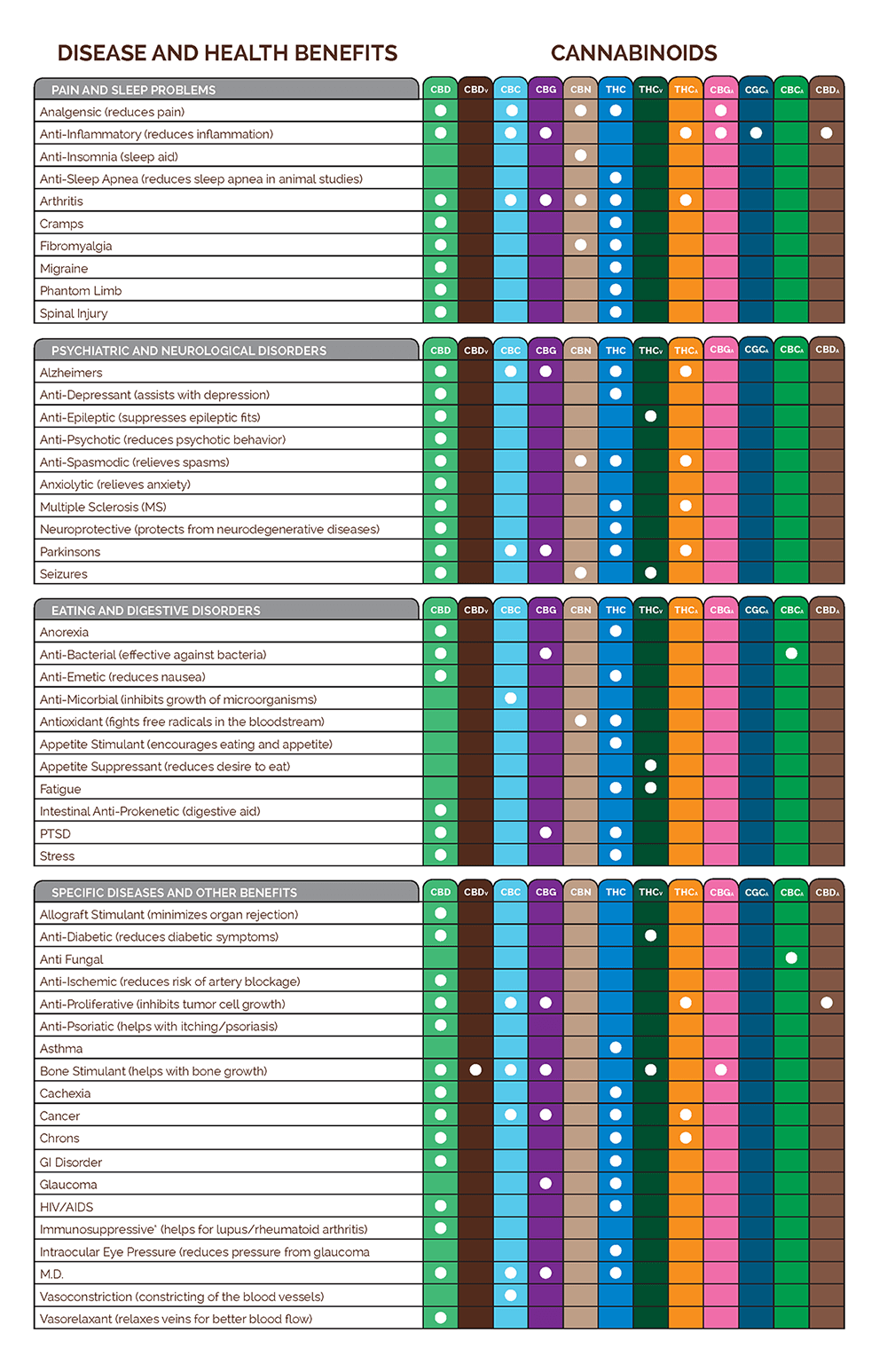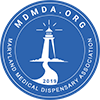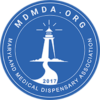The cannabis plant contains over 100 active compounds called cannabinoids, which are found within the flower (buds), leaf, and stem. These plant compounds are known as phytocannabinoids and they work to mimic or counteract the endocannabinoids found naturally within the human body. When a specific cannabinoid or combinations of cannabinoids binds to a specialized receptor, an event or a series of events is triggered within the cell, resulting in a change in the cell’s activity, its gene regulation and or the signals that it sends to neighboring cells. This process is called “signal transduction”.
Two of the more commonly known phytocannabinoids are tetrahydrocannabinol (THC) and cannabidiol (CBD). Research on the benefits of these two compounds in isolation is well established. THC demonstrates analgesic, anti-emetic, and anti-inflammatory properties. CBD possesses anti-psychotic, anti-seizure, and anti-anxiety properties. Good evidence now shows that cannabinoids work better together and that isolation may be limiting the potential for aiding in other medical conditions.
For a thorough description of each cannabinoid featured in this graphic, please see below.

Cannabichromene (CBC)
Evidence has suggested that it may play a role in the anti-inflammatory and anti-viral effects of cannabis, and may contribute to the overall analgesic effects of medical cannabis. A study done in March 2010 showed that CBC along with cannabidiol (CBD) and tetrahydrocannabinol (THC) have antidepressant effects. Another study showed that CBC helps promote neurogenesis.
Cannabidiol (CBD)
Not all cannabinoids are colorless. One of the most brightly yellow-colored cannabinoids is CBD, a very valuable cannabinoid. CBD has tremendous medical potential. This is particularly true when the correct ratio of CBD to THC is applied to treat a particular condition. CBD acts as an antagonist at both the CB1 and CB2 receptors, yet it has a low binding affinity for both. This suggests that CBD’s mechanism of action is mediated by other receptors in the brain and body.
Cannabidivarin (CBDV)
Like THCV, CBDV differs from CBD only by the substitution of a pentyl (5 carbon) for a propyl (3 carbon) sidechain. Although research on CBDV is still in its initial stages, recent studies have shown promise for its use in the management of epilepsy. This is due to its action at TRPV1 receptors and modulation of gene expression.
Cannabinol (CBN)
CBN is a mildly psychoactive cannabinoid that is produced from the degradation of THC. There is usually very little to no CBN in a fresh plant. CBN acts as a weak agonist at both the CB1 and CB2 receptors, with greater affinity for CB2 receptors than CB1. The degradation of THC into CBN is often described as creating a sedative effect, known as a “couch lock.”
CGCa
CGCa is a cannabinoid shown to reduce inflammation.
Tetrahydrocannabinolic Acid (THCA)
THCA is the main constituent in raw cannabis. THCA converts to Δ9-THC when burned, vaporized, or heated at a certain temperature. THCA, CBDA, CBGA, and other acidic cannabinoids hold the most COX-1 and COX-2 inhibition, contributing to cannabis’ antiinflammatory effects. This cannabinoid also acts as an antiproliferative and antispasmodic.
Cannabidiolic Acid (CBDA)
CBDA, CBD-acid or CBD-a is the main form in which CBD exists in the cannabis plant, along with THCA (THC-acid). CBD is obtained through non-enzymatic decarboxylation from the acidic form of the cannabinoid, this reaction taking place when the compounds are heated. Heating or catalyzing CBDa transforms it into CBD, thereby increasing the total CBD level. Research shows higher concentrations of CBDA displayed more pronounced antimicrobial activity than CBD alone.
Cannabigerol (CBG)
A non-psychoactive cannabinoid, CBG’s antibacterial effects can alter the overall effects of cannabis. CBG is known to kill or slow bacterial growth, reduce inflammation, (particularly in its acidic CBGA form,) inhibit cell growth in tumor/cancer cells, and promote bone growth. It acts as a low-affinity antagonist at the CB1 receptor. CBG pharmacological activity at the CB2 receptor is currently unknown.
Cannabigerolic Acid (CBGa)
Cannabigerolic Acid is formed when geranyl pyrophosphate combines with olivetolic acid within the cannabis plant. It is thanks to CBGa that all other medicinal effects of cannabis are possible. Cannabigerolic acid (CBGa) can be thought of as the stem cell cannabinoid, which becomes THCa/THC, CBDa/CBD, CBCa/CBC, and CBG. It does this through different types of biosynthesis, where chemicals combine to form new compounds, examples being theTHC biosynthase and the CBD biosynthase. CBGa is a powerful vasodilator and has neuroprotective abilities, it is effective in decreasing inflammation, and research has shown it to block receptors that cause cancer cell growth. Because it is non-psychotropic, CBGa has a promising wide range of potential applications, including an analgesic, therapy for psoriasis, and as an antidepressant.
Cannabichromenic Acid (CBCA)
CBCA is produced by CBGA in raw cannabis plants. CBCA then goes on to produce other cannabinoids (CBC, CBL, and CBLA) when heated or aged. Like CBDA and THCA, CBCA is the parent cannabinoid of CBC. CBCA has been shown to offer anti-fungal and anti-inflammatory effects.
Tetrahydrocannabinol (THC)
Delta-9-tetrahydrocannabinol (THC) is a phytocannabinoid, and typically the most abundant cannabinoid present in cannabis products on the market today. THC can be derived from THCA by non-enzymatic decarboxylation during storage and consumption. It is responsible for the well-documented psychoactive effects experienced when consuming cannabis. When you smoke or ingest cannabis, THC travels into the bloodstream and eventually binds to cannabinoid receptors throughout your body. These receptor sites affect memory, concentration, pleasure, coordination, sensory and time perception, appetite and many more important functions. Mild side effects of larger doses of THC can include anxiety, elation, burning eyes, dry mouth, shaking/trembling, increased heart rate and/or shortness of breath (or at least the perception of such) and short-term memory loss. Smoking or ingesting too much THC in a short period of time can intensify and alter its effects.
Tetrahydrocannabivarin (THCV)
THCV is a minor cannabinoid found in only some strains of cannabis. The only structural difference between THCV and THC is the presence of a propyl (3 carbon) group, rather than a pentyl (5 carbon) group, on the molecule. Though this variation may seem subtle, it causes THCV to produce very different effects than THC. These effects include a reduction in panic attacks, suppression of appetite, and the promotion of bone growth.




